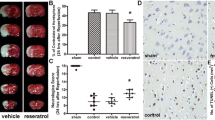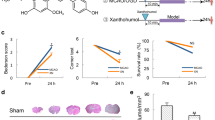Abstract
Oxidative stress damage plays a vital role in cerebral ischemia/reperfusion (I/R) pathogenesis. The nuclear factor erythroid 2-related factor 2 (Nrf2)/antioxidant response element (ARE) signaling pathway can be activated by pharmacological and dietary means to attenuate cellular oxidative stress. Resveratrol, a plant-derived polyphenolic compound, has antioxidant property. Recent studies have demonstrated that resveratrol has protective effects against cerebral I/R injury. However, little is known about its mechanism. Hence, this study identified the neuroprotective effect of resveratrol pretreatment and elucidate the Nrf2/ARE signaling mechanism after focal cerebral I/R injury in rats. Adult male Sprague–Dawley rats were randomly assigned to sham-operated group, ischemia/reperfusion physiological saline-treated group, and ischemia/reperfusion resveratrol-pretreatmented (15 and 30 mg/kg) groups. Rats were pretreatmented with resveratrol or physiological saline of corresponding volume administered intraperitoneally for 7 days before surgery and 30 min before middle cerebral artery occlusion. At 24 h after reperfusion, neurological score, infarct volume, and brain water content were assessed. Oxidative stress was evaluated by malondialdehyde (MDA) levels and superoxide dismutase (SOD) activity. Pathological changes of brain tissue were observed by HE staining. RT-PCR and Western blot analysed the expression of nuclear factor erythroid 2-related factor 2 (Nrf2) and heme oxygenase-1 (HO-1). TUNEL staining detected apoptotic cells. The protein expression of Caspase-3 were studied by immunohistochemistry. Resveratrol pretreatment significantly ameliorated neurological scores, reduced infarct volume and brain water content, decreased MDA levels, restored the SOD activity, upregulated the protein and mRNA expression of Nrf2 and HO-1, downregulated the protein expression of caspase-3. TUNEL-positive cells significantly decreased compared with the physiological saline-treated group. HE staining also showed that resveratrol significantly improved neuronal injury. These results showed that resveratrol pretreatment had neuroprotective effects on cerebral I/R injury. This neuroprotective effect is likely exerted by upregulated expression of transcription factor Nrf2 and HO-1 to ameliorate oxidative damage, decreased the protein expression of caspase-3. Our finding is important for understanding the neuroprotective mechanism of resveratrol and promoting its clinical therapeutic utility.










Similar content being viewed by others
References
Siesjö BK (1992) Pathophysiology and treatment of focal cerebral ischemia. Part II: mechanisms of damage and treatment. J Neurosurg 77:337–354
Wong Ch, Crack PJ (2008) Modulation of neuro-inflammation and vascular response by oxidative stress following cerebral ischemia-reperfusion injur. Curr Med Chem 15:1–14
Ergün O, Ergün G, Oktem G et al (2007) Enteral resveratrol supplementation attenuates intestinal epithelial inducible nitric oxide synthase activity and mucosal damage in experimental necrotizing enterocolitis. J Pediatr Surg 42:1687–1694
De la Lastra CA, Villegas I (2007) Resveratrol as an antioxidant and pro-oxidant agent: mechanisms and clinical implications. Biochem Soc Trans 35:1156–1160
Candelario-Jalil E, de Oliveira AC, Gräf S et al (2007) Resveratrol potently reduces prostaglandin E2 production and free radical formation in lipopolysaccharide-activated primary rat microglia. J Neuroinflamm 4:25
Ban JY, Cho SO, Choi SH et al (2008) Neuroprotective effect of Smilacis chinae rhizome on NMDA-induced neurotoxicity in vitro and focal cerebral ischemia in vivo. J Pharmacol Sci 106:68–77
De Lorgeril M, Salen P, Martin JL et al (1999) Mediterranean diet, traditional risk factors, and the rate of cardiovascular complications after myocardial infarction: final report of the Lyon Diet Heart Study. Circulation 99:779–785
Dong W, Li N, Gao D et al (2008) Resveratrol attenuates ischemic brain damage in the delayed phase after stroke and induces messenger RNA and protein express for angiogenic factors. J Vasc Surg 48:709–714
Shin JA, Lee H, Lim YK et al (2010) Therapeutic effects of resveratrol during acute periods following experimental ischemic stroke. J Neuroimmunol 227:93–100
Ishii T, Itoh K, Takahashi S et al (2000) Transcription factor Nrf2 coordinately regulates a group of oxidative stress-inducible genes in macrophages. J Biol Chem 275:16023–16029
Kobayashi M, Yamamoto M (2005) Molecular mechanisms activating the Nrf2-Keap1 pathway of antioxidant gene regulation. Antioxid Redox Signal 7:385–394
Pearson KJ, Lewis KN, Price NL et al (2008) Nrf2 mediates cancer protection but not prolongevity induced by caloric restriction. Proc Natl Acad Sci USA 105:2325–2330
Ping Z, Liu W, Kang Z, Cai J et al (2010) Sulforaphane protects brains against hypoxic-ischemic injury through induction of Nrf2-dependent phase 2 enzyme. Brain Res 1343:178–185
Ungvari Z, Bagi Z, Feher A et al (2010) Resveratrol confers endothelial protection via activation of the antioxidant transcription factor Nrf2. Am J Physiol Heart Circ Physiol 299:H18–H24
Thimmulappa RK, Mai KH, Srisuma S et al (2002) Identification of Nrf2-regulated genes induced by the chemopreventive agent sulforaphane by oligonucleotide microarray. Cancer Res 62:5196–5203
Motterlini R, Green CJ, Foresti R (2002) Regulation of heme oxygenase-1 by redox signals involving nitric oxide. Antioxid Redox Signal 4:615–624
Berberat PO, Katori M, Kaczmarek E et al (2003) Heavy chain ferritin acts as an antiapoptotic gene that protects livers from ischemia reperfusion injury. FASEB J 17:1724–1726
Nakao A, Neto JS, Kanno S et al (2005) Protection against ischemia/reperfusion injury in cardiac and renal transplantation with carbon monoxide, biliverdin and both. Am J Transplant 5:282–291
Longa EZ, Weinstein PR, Carlson S et al (1989) Reversible middle cerebral artery occlusion without craniectomy in rats. Stroke 20:84–91
Tatlisumak T, Carano RA, Takano K et al (1998) A novel endothelin antagonist, A-127722, attenuates ischemic lesion size in rats with temporary middle cerebral artery occlusion: a diffusion and perfusion MRI study. Stroke 29:850–857
Hatashita S, Hoff JT, Salamat SM (1988) Ischemic brain edema and the osmotic gradient between blood and brain. J Cereb Blood Flow Metab 8:552–559
Wei X, Liu H, Sun X (2005) Hydroxysafflor yellow A protects rat brains against ischemia-reperfusion injury by antioxidant action. Neurosci Lett 386:58–62
Fridovich I (1983) Superoxide radical: an endogenous toxicant. Annu Rev Pharmacol Toxicol 23:239–257
Zhu C, Wang X, Cheng X et al (2009) Post-ischemic hypothermia-induced tissue protection and diminished apoptosis after neonatal cerebral hypoxia-ischemia. Brain Res 996:67–75
Mattson MP, Duan W, Pedersen WA (2001) Neurodegenerative disorders and ischemic brain diseases. Apoptosis 6:69–81
Broughton BR, Reutens DC, Sobey CG (2009) Apoptotic mechanisms after cerebral ischemia. Stroke 40:e331–e339
Denes L, Szilágyi G, Gál A et al (2006) Talampanel a non-competitive AMPA-antagonist attenuates caspase-3 dependent apoptosis in mouse brain after transient focal cerebral ischemia. Brain Res Bull 70:260–262
Lin YL, Chang HC, Chen TL et al (2010) Resveratrol protects against oxidized LDL-induced breakage of the blood-brain barrier by lessening disruption of tight junctions and apoptotic insults to mouse cerebrovascular endothelial cells. J Nutr 140:2187–2192
Candelario-Jalil E (2009) Injury and repair mechanisms in ischemic stroke: considerations for the development of novel neurotherapeutics. Curr Opin Investig Drugs 10:644–654
Chan PH (1996) Role of oxidants in ischemic brain damage. Stroke 27:1124–1129
Zhao J, Yu S, Zheng W et al (2010) Curcumin improves outcomes and attenuates focal cerebral ischemic injury via antiapoptotic mechanisms in rats. Neurochem Res 35:374–379
Karabulut AB, Kirimlioglu V, Kirimlioglu H et al (2006) Protective effects of resveratrol on spleen and ileum in rats subjected to ischemia-reperfusion. Transplant Proc 38:375–377
Leonard SS, Xia C, Jiang BH et al (2003) Resveratrol scavenges reactive oxygen species and effects radical-induced cellular responses. Biochem Biophys Res Commun 309:1017–1026
Yen GC, Duh PD, Lin CW (2003) Effects of resveratrol and 4-hexylresorcinol on hydrogen peroxide-induced oxidative DNA damage in human lymphocytes. Free Radic Res 37:509–514
Balakrishna S, Lomnicki S, McAvey KM et al (2009) Environmentally persistent free radicals a amplify ultrafine particle mediated cellular oxidative stress and cytotoxicity. Part Fibre Toxicol 6:11
Calkins MJ, Jakel RJ, Johnson DA et al (2005) Protection from mitochondrial complex II inhibition in vitro and in vivo by Nrf2-mediated transcription. Proc Natl Acad Sci USA 102:244–249
Shih AY, Li P, Murphy TH (2005) A small-molecule-inducible Nrf2-mediated antioxidant response provides effective prophylaxis against cerebral ischemia in vivo. J Neurosci 25:10321–11035
Satoh T, Kosaka K, Itoh K et al (2008) Carnosic acid, a catechol-type electrophilic compound, protects neurons both in vitro and in vivo through activation of the Keap1/Nrf2 pathway via S-alkylation of targeted cysteines on Keap1. J Neurochem 104:1116–1131
Yang C, Zhang X, Fan H et al (2009) Curcumin upregulates transcription factor Nrf2, HO-1 expression and protects rat brains against focal ischemia. Brain Res 28:133–141
Son TG, Camandola S, Arumugam TV et al (2010) Plumbagin, a novel Nrf2/ARE activator, protects against cerebral ischemia. J Neurochem 112:1316–1326
Sakata Y, Zhuang H, Kwansa H et al (2010) Resveratrol protects against experimental stroke: putative neuroprotective role of heme oxygenase 1. Exp Neurol 224:325–329
Acknowledgments
This work was supported by grants from the National Nature Science Foundation of China (grant no. 81071119) and the Foundation for Science, Chongqing Bureau of Public Health (grant no. 2009-2-359).
Author information
Authors and Affiliations
Corresponding author
Rights and permissions
About this article
Cite this article
Ren, J., Fan, C., Chen, N. et al. Resveratrol Pretreatment Attenuates Cerebral Ischemic Injury by Upregulating Expression of Transcription Factor Nrf2 and HO-1 in Rats. Neurochem Res 36, 2352–2362 (2011). https://doi.org/10.1007/s11064-011-0561-8
Received:
Revised:
Accepted:
Published:
Issue Date:
DOI: https://doi.org/10.1007/s11064-011-0561-8




